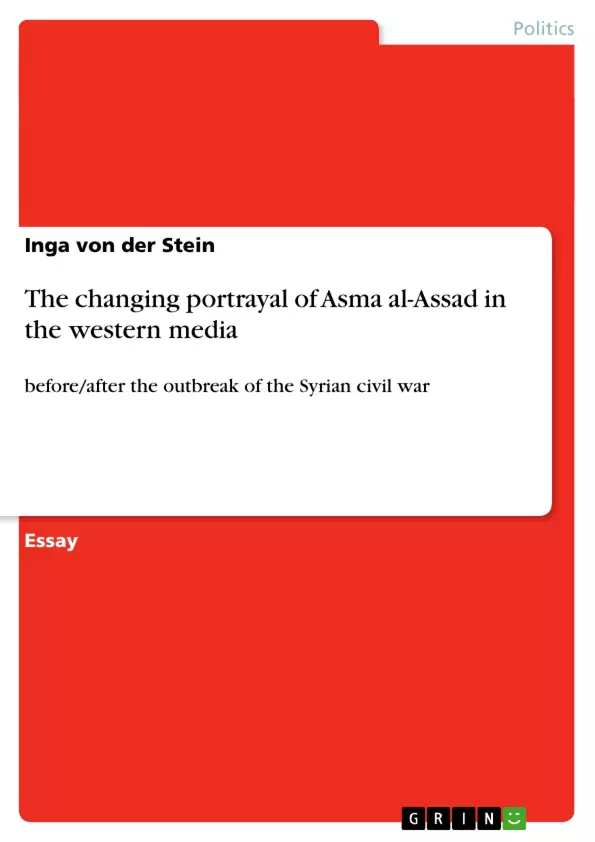Over the past two years, the civil war in Syria has been one of the major topics in Western media. It began in 2011 with demonstrations against the Assad regime. It is estimated by the United Nations that over 100,000 have died and millions have been displaced since then (Tomasevic, 2013). One of the major focuses set by the media is on Bashar al-Assad, the current President of Syria, who is called upon by many in- and outside the country to resign (Wilkinson & Smith-Spark, 2013). In the early terms of his Presidency, Assad symbolized a sign of hope for a more modern and democratic Syria – a significant factor was his wife, born and educated in Great Britain, who spoke out publicly for human rights and peace. The two were represented as a glamorous and westernized couple by the press throughout the years. This perception abruptly changed with the uprisings in Syria which have begun in March 2011 (Goodspeed, 2012). However, Bashar al-Assad’s wife, Asma, is still portrayed as a caring First Lady by social media such as instagram and facebook used by the Assad Regime (Dewey, 2013). As a result of her presentation as a liberal and peace-aiming figure in the past, many, in particular women, still hope that the country’s First Lady will stand up against violence, however, she remains silent until this point (“UN ambassador wives”, 2012).
One wonders, how such a positive and one-sided depiction of Asma al-Assad in the Western media was achieved in the first place? Who was holding the reins for this? And why were the journalists more absorbed by her outward appearance than by the fact that she is the wife of a dictator? These are questions this paper examines. Therefore, I studied Western media, in particular fashion magazines, tabloids but also well-respected newspapers such as the Guardian or the Washington Post in order to give my reader a varied overview of the way Asma al-Assad was represented in different tubes of the Western press. The answers serve to consider what the contrasting portrayal of Asma al-Assad can reveal in general about the accuracy and the function of the media in the West, being influenced both by propaganda and the interests of the Western readership. This is why I laid my focus on the portrayal of Asma al-Assad in the Western media, comparing her depiction before and after the outbreak of the civil war in Syria. I have structured this paper into two parts to demonstrate the disparity of her representation in the media in this context.
Inhaltsverzeichnis (Table of Contents)
- Introduction
- The media portrayal of Asma al-Assad
- Before the outbreak of civil war in Syria
- After the outbreak of civil war in Syria
Zielsetzung und Themenschwerpunkte (Objectives and Key Themes)
This paper examines the changing portrayal of Asma al-Assad in Western media before and after the outbreak of the Syrian civil war. It analyzes how Asma's image shifted from a positive and idealized representation as a modern Arab woman to a negative and controversial figure.
- The evolution of Asma al-Assad's image in Western media
- The role of propaganda and Western readership interests in shaping media narratives
- The impact of the Syrian civil war on the perception of Asma al-Assad
- The contrasting depiction of Asma before and after the civil war
- The accuracy and function of Western media in the context of political conflict
Zusammenfassung der Kapitel (Chapter Summaries)
The first part of the paper focuses on Asma al-Assad's media portrayal from 2000, when she became Syria's First Lady, until the outbreak of the Syrian civil war in 2011. It highlights how Asma's Western background, her work in finance, and her establishment of charitable projects contributed to her positive image as a modern and progressive figure in the Arab world. The media often portrayed her as a fashion icon, comparing her to Queen Rania of Jordan. Her image was also linked to her husband's efforts to promote social change and reforms.
The second part of the paper examines the shift in Asma's representation after the outbreak of the civil war. It explores how the media's portrayal of her transformed from positive to negative, with her once-praised fashion sense and charity work becoming subjects of criticism. The paper also analyzes the reasons for this sudden inversion, highlighting the role of propaganda and the changing political climate.
Schlüsselwörter (Keywords)
This paper explores the portrayal of Asma al-Assad in Western media, focusing on her image as a symbol of hope and social change before the Syrian civil war. Key themes include the influence of propaganda, the role of Western readership interests, and the contrasting depictions of Asma before and after the conflict. The paper analyzes Western media coverage, including fashion magazines, tabloids, and respected newspapers, to demonstrate the impact of the Syrian civil war on the perception of Asma al-Assad.
- Quote paper
- Inga von der Stein (Author), 2013, The changing portrayal of Asma al-Assad in the western media, Munich, GRIN Verlag, https://www.grin.com/document/264962



